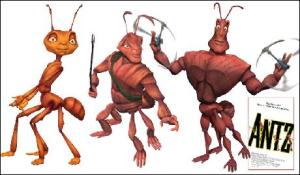What Bugs Me In Animation?
Bugs and animation have long enjoyed an insectuous relationship. And why not? Bugs come in a variety of shapes, sizes and colours; they can walk, crawl, wriggle, hop and fly. That gives animators a lot to, er, draw on.
Bugs come with a built-in hero/villain dynamic that we can tap into for character and story. Bugs instinctively arouse our sympathies or fears; they can be cute and vulnerable or scary and dangerous. They pollinate our plants and make us honey; or they can suck our blood or kill us with a venomous sting.
That’s not what bugs me.
What does bug me? Inaccurate bug anatomy. Specifically: number of legs.
Take a look at Jiminy Cricket, one of the first animated insects to hop onto the big screen. The first thing you notice about him, other than that he’s quite a snappy dresser, is that he has two arms and two legs. Total number of appendages: four. That’s TWO less than his real-life cricket counterpart.
This bugs me.
I don’t know why exactly. Intellectually, I get that it’s easier to animate four limbs than six. Similarly, hands are often simplified in animation: four digits (three fingers and a thumb) rather than five. When it comes to digits or legs, four of anything in a design is enough to give the impression of “lots.”
I had hoped that computer-assisted animation would usher in a glorious anatomically-correct era of insect animation. In 1998, two rival movies with CGI insect characters were released: Antz (Dreamworks) and A Bug’s Life (Pixar/Disney). To my amazement, the ants in Antz actually had six legs! To my disappointment, the ants in A Bug’s Life had four. To their credit, their grasshopper villains had six. The caterpillar had even more.
Canadian productions have gone either way when it comes to insect limb count in bug-based animated series.
In Roboroach (Portfolio Entertainment/Helix Animation) Rube the cockroach has six legs but his brother Reg has four.
In Erky Perky (CCI Entertainment/Ambience Entertainment) both bugs have four limbs.
In Maya the Bee (developed by Thunderbird Films and Studio 100) the bees have four limbs, but Flip the Grasshopper has six.
Six-leggedness seems to be used when animators want to give emphasize the “bugginess” of a character for comic or scary effect. When characters have four limbs, they more closely mimic the human behaviour the animators are sending up by anthropomorphizing bugs.
Let’s face it. When a character sings, dances, moralizes, and wears a three-piece suit, gloves and a top hat, and carries an umbrella, he’s not really an insect. He’s just a little person who just happens to have a green exoskeleton!
And that’s the important thing to keep in mind when it comes to writing for non-human characters. Talking insects (or animals or robots for that matter) stand in for humans. Their characters need to be just as consistent, their actions as well-motivated, their reactions as believable as if they were actual people.
What does set insect characters apart is any non-human capabilities they might have: flight, strength, flexibility, multitasking, the ability to cling to the sides and undersides of objects, or to bounce back from being squashed or swatted with no lasting physical damage. A canny animation writer will exploit the visual possibilities to the fullest.
And one last thing that bugs me about bugs in animation…inaccurate portrayal of gender roles in insect communities! In nature, it’s the females who do all the work in beehives and ant colonies. The male drones just hang out and mate with the queen. Of course, if you’re writing for a children’s series, that’s a scenario that’s not going to, er, fly.







